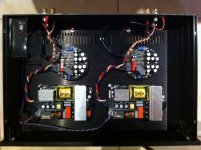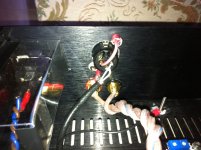Why should the load be different between different NC modules? Most are talking about getting hot under idle conditions. I can't really notice a difference in temperature of the casing when the amps are idling (I leave them on all the time) or playing with lots of power.
I think it depends on the speakers. My Coldamp get hot to . No difference between NCORE and Coldamp in that case.
Adding sugar is a rather well known method which is typically used to make things sweeter. So if we add some sugar on top of our speakers, it will sound sweeter.
This is the same type of argument used for the "Ultra tweeter". It's quasi-scientific.
Eating and drinking something tasty is nevertheless a well known method of making a system under evaluation more digestible
Maybe the sugar should be placed on the table instead of on the speaker. Pseudo-scientific or not, that probably depends more on what you are to prove...
same here, mounted in an aluminium cabinet, no heat sinks, and gets only lukewarm. they drive some low efficiency speakers, so the do have to workSounds like something is wrong. I have NC400 with SMPS and it only gets lukewarm, even without external cooling.
the "microphone" cable supplied with the amps (intended to connect the amp to the XLRs) you mean? I used them, what sort of experience are you looking for?Is there anyone who has some experience with the new input cable that comes with the nCore?
the "microphone" cable supplied with the amps (intended to connect the amp to the XLRs) you mean? I used them, what sort of experience are you looking for?
I ordered the nCores earlier this year and got different (yes, xlr) cables shipped with it. Now I received the new ones. Build on Hypex specs I guess. I'm curious if there is a big difference with the previous ones before I deassemble my 5 channel amp.
Last edited:
the "microphone" cable supplied with the amps (intended to connect the amp to the XLRs) you mean? I used them, what sort of experience are you looking for?
I guess he is looking for a subjective analysis of whether there is any difference to the original one?
That is the information I received from Hypex:
"Dear Customer,
The runaway success of the NC400 has spurred Hypex to develop a signal cable to match the quality of the amplifier. The QuietConduit cable, which draws on our experience designing the HG interlinks, is now being shipped as standard with the NC400 module. To earlier customers who still have the old cable we would like to offer the opportunity of receiving a set of QuietConduit signal cables free of charge"
I ordered the cables but I've no intention of replacing my current very short cables but might use them in the future if I'm going to change my setup and my current in use cables are too short for the new setup. (Maybe I'm going to bi-amp my front speakers and then I might use two of them in a new enclosure of one SMPS600 with two NCore400.)
"Dear Customer,
The runaway success of the NC400 has spurred Hypex to develop a signal cable to match the quality of the amplifier. The QuietConduit cable, which draws on our experience designing the HG interlinks, is now being shipped as standard with the NC400 module. To earlier customers who still have the old cable we would like to offer the opportunity of receiving a set of QuietConduit signal cables free of charge"
I ordered the cables but I've no intention of replacing my current very short cables but might use them in the future if I'm going to change my setup and my current in use cables are too short for the new setup. (Maybe I'm going to bi-amp my front speakers and then I might use two of them in a new enclosure of one SMPS600 with two NCore400.)
Last edited:
one thing I tend to do recently is pour some hot melt glue or even epoxy on joints that could lead to problems. a wire is a wire and sooner or later will be torn at its weakest spot (normally, the joint).Let us hope the wires are better fitted to the connector on the new cable. They came loose just by looking at them on the old one.
I got the same email quoted above, but never bothered to ask for new cables....
Finally assembled my dual mono nCore.
Is my wiring correct?
XLR pin 1 to ground of chassis
XLR pin 2 to blue wire of input cable
XLR pin 3 to white wire of input cable
Ground of chassis to shield/sheath of input cable.
All AC input, SMPS600 power supply harness and speaker output cable twisted.
I used a bottom mounted on/off switch, located at the front left of the chassis.
PS. Sorry the flash overexposed the colour of the blue/white wires of the Mogami/QuietConduit input cable so they both appear white.
Is my wiring correct?
XLR pin 1 to ground of chassis
XLR pin 2 to blue wire of input cable
XLR pin 3 to white wire of input cable
Ground of chassis to shield/sheath of input cable.
All AC input, SMPS600 power supply harness and speaker output cable twisted.
I used a bottom mounted on/off switch, located at the front left of the chassis.
PS. Sorry the flash overexposed the colour of the blue/white wires of the Mogami/QuietConduit input cable so they both appear white.
Attachments
Last edited:
The casework may not have good continuity from rear panel to bottom panel. I use Hifi2000 cases and found they need a cable link between panels for a good ground.
Also you should have mains cables double insulated if no earth connection.
I assume the speaker terminals are isolated from the back panel(?)
Also you should have mains cables double insulated if no earth connection.
I assume the speaker terminals are isolated from the back panel(?)
Picked this up from another forum about the new cables (Mogami?):
I would certaintly like to see the explanation of this from Hypex.Bruno: "Since it's wire we're talking about, the difference won't be enormous. But you should notice improved neutrality and reduced granularity in the top octaves."
can't see how a link to the discussion would hurt.Picked this up from another forum about the new cables (Mogami?):
I would certaintly like to see the explanation of this from Hypex.
The casework may not have good continuity from rear panel to bottom panel. I use Hifi2000 cases and found they need a cable link between panels for a good ground.
I will look into that, and check the continuity with my multimeter.
Yes, I was planning to do that. Then I figured that the anodized surface is non conductive, so I only placed an insulating layer over the top of the AC input terminals to keep prying fingers off.Also you should have mains cables double insulated if no earth connection.
I assume the speaker terminals are isolated from the back panel(?)
Yes, by intrinsic design of the speaker terminals.
Picked this up from another forum about the new cables (Mogami?):
I would certaintly like to see the explanation of this from Hypex.
Explain reduced granularity?
That...
is a fairly commonly used term to describe a certain sound quality. Often in association with solid state vs. tube, where solid state has traditionally sounded more granular, and tube gear sounded more liquid.
Consider a photograph as a visible example of the term: film grain means a less continuous tone, a less smooth tone. Now extrapolate to audio:
More liquid=smoother, less granular.
Explain reduced granularity?
is a fairly commonly used term to describe a certain sound quality. Often in association with solid state vs. tube, where solid state has traditionally sounded more granular, and tube gear sounded more liquid.
Consider a photograph as a visible example of the term: film grain means a less continuous tone, a less smooth tone. Now extrapolate to audio:
More liquid=smoother, less granular.
is a fairly commonly used term to describe a certain sound quality. Often in association with solid state vs. tube, where solid state has traditionally sounded more granular, and tube gear sounded more liquid.
Consider a photograph as a visible example of the term: film grain means a less continuous tone, a less smooth tone. Now extrapolate to audio:
More liquid=smoother, less granular.
Thanks Barrows,
I read Wikipedia and it said something like ' reduced granularity = less detail....' so I wondered...
- Status
- Not open for further replies.
- Home
- Amplifiers
- Class D
- Hypex Ncore

